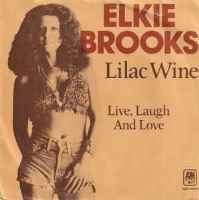
A few weeks ago Paul Gambaccini, on his Sunday show, mentioned that he was having a conversation with someone and they were discussing singers who still have their voice many years after their career began and he said, that Tom Jones was probably the only one from the 60s. Well, I disagree, there are a few, Roger Daltrey, Paul Jones, Helen Shapiro and Mick Jagger immediately spring to mind. Another lady who began in the 60s, but didn’t find success until the 70s is the wonderful Elkie Brooks. I had the pleasure of seeing her in Bromley exactly two years ago and she was certainly as powerful as ever. Only last week I saw some footage of her at the Shrewsbury Folk Festival in 2024 and that was proof enough.
As a collector of original versions of well-known songs, it’s always riled me that I have never been able to get hold of the original version of this week’s suggestion, the reason being is that it was first performed in a Broadway revue show called Dance Me A Song and no cast recording was made. It was staged at the Royale Theatre between 20th January and 18th February 1950 with all the music and lyrics written by James Shelton. It was a flop, but one great song survived and recorded by many.
James Shelton was an actor, composer and writer and had appeared in Annie Dear (1924), New Faces of 1934 (1934), Who’s Who (1938), The Straw Hat Revue (1939), Mrs. Patterson (1954) and Almost Crazy (1955). In later years, as a writer, he contributed to The Victor Borge Show, The Jackie Gleason Show and his last known work was with The Honeymooners TV special in 1976. As a song composer, he occasionally wrote under the pseudonyms J. Skelton, James Hampton and Jay Shelton.
It was Hope Foye who sung it in the original show. Hope was a classically trained soprano as well as a folk and jazz singer. She was born Frances Hope Wainwright in Middletown, Connecticut on 2nd September 1921 and died on 5th January 2025 at the age of 103. In the 1950s, she sang extensively alongside Pete Seeger and the Weavers, so much so that she was often nicknamed the fifth Weaver. She also performed on stage with Paul Robeson at Madison Square Garden and gained international recognition after winning a singing prize at the World Youth Music Festival in East Berlin. Later in life she became a civil rights activist and moved to Mexico where she spent 10 years of her life and learned fluent Spanish. I was pleased to learn that she is survived by two daughters, four grandchildren, seven great-grandchildren and one great-great-grandchild.
Lilac Wine is a captivating song that tells the story of a lost lover and how the protagonist takes solace in a potent wine that they have made from the lilac tree they sat beneath to mourn their loss. The song almost makes the wine take over your mind and soul, which, if you have enough of any intoxicating liquor can probably happen, but this is almost done on purpose knowing that with enough mind-altering alcohol, it will make them believe that the lover will return with its sweet and headiness being compared, in effect, to that lost love. Midway through the song, and as the song starts to build, she clearly begins to hallucinate his arrival in the distance, but too far away to be clear when we hear the line, ‘Listen to me, I cannot see clearly, Isn’t that he coming to me, nearly here?’
The first recorded version was by the distinctly wavy voice of Eartha Kitt in June 1953, her version is good, but doesn’t have the feeling that Nina Simone put into it when she recorded it in 1966. In my opinion, only Elkie Brooks can make you feel her pain and loss in her version in 1978, which is possibly the reason it’s been the only hit version…so far. In 1994, three years before his untimely death in 1997, Jeff Buckley recorded a sombre version faithful to Nina Simone’s. He once said, “A beautiful song I wish I wrote.”
The song has moved many people for example, Depeche Mode’s Dave Gahan said of it, “It’s having a dependency. It’s having a love – a true love that you feel and you know is there. And maybe that love at that particular time is a substance,” when he covered it in 2021 with his band the Soul Savers. One of my other favourite versions is by Jeff Beck with his haunting guitar and featured the delicate voice of Imelda May in 2010. Even Miley Cyrus gave it a go in 2012 at her Backyard Sessions. It seems whoever covers it, tried to make it their own and many succeed.
Surprisingly little else is known about the song’s author, James Shelton. All that seems to be available is that his middle initial was H, but not what it stood for. There is no known birth or death date for him or even where he was born. If you happen to come across a picture of him, he bears a resemblance to the actor Peter Butterworth. Although there’s no definitive proof, as Songfacts points out, James may be been inspired by a passage from the 1924 book Sorrow In Sunlight by Ronald Firbank which reads, ‘Offering a light, lilac wine, sweet and heady, Miami circled, here and there’
In a nutshell, this song is a yearning for a lost love that is so intense it’s intoxicating.